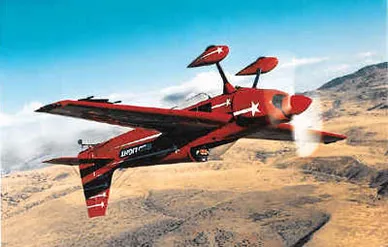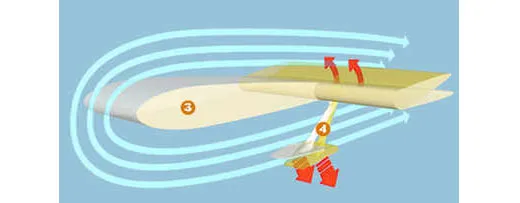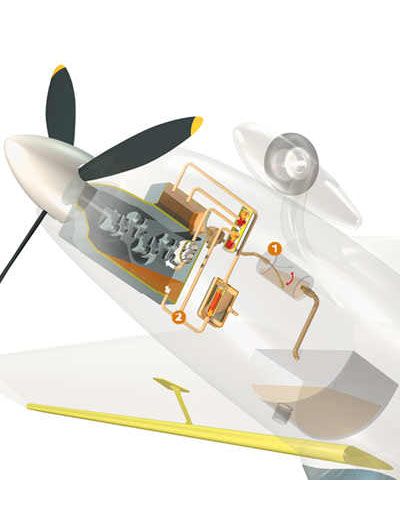Flying Upside Down
Devices an aerobatic airplane uses to defy gravity—and convention
Gravity and other forces conspire against conventional flight, but they are positively Machiavellian about inverted flight. Pity the first pilot who rolled inverted and sailed blithely along, only to hear the engine cough and die of fuel starvation when the gas settled in the top of the tank, or have the engine seize when the oil did likewise.
Engineers and designers have conspired in return. Here are a few devices that enable inverted flight and transitional maneuvers, or at least make them less of a struggle.
Inverted fuel systems
Most aerobatic airplanes with inverted fuel and oil systems use fuel injection rather than a carburetor. When a carburetor is inverted, it can no longer meter fuel, and the float rises and cuts off the incoming supply. A fuel injector, which doesn't care what attitude it is in, measures airflow and meters the proper ratio of fuel to each cylinder so that each receives a constant flow of the same fuel-air mixture.
To ensure the flow from fuel tank to fuel injector, aerobatic aircraft with the fuel tank in the fuselage have a "flop tube," a flexible hose with a weight in the free end, plugged into the fuel tank. In normal flight, the weighted end of the hose flops to the bottom of the tank and draws fuel from there. When the airplane rolls inverted, the weighted end flops to the top of the tank (1 in diagram below), with the fuel. Regardless of the aircraft's attitude, fuel and flop tube end up in the same spot.
Aerobatic airplanes that have fuel tanks in the wing use a small "header tank," which is connected to the wing tanks. In normal flight, fuel gravity-feeds down to fill the header tank, which is connected to the suction side of the fuel pump. When the airplane rolls inverted, the header tank is now above the engine, and fuel gravity-feeds from the header tank to the fuel pump. A check valve in the line from the main tank to the header tank stops fuel from draining back into the main tank when the airplane is inverted.
Inverted oil systems
Engines that use an external oil tank-"dry sump" engines-have a device similar to a flop tube that can reach oil in almost any attitude. In wet sump engines, in which oil is stored internally in a sump at the bottom of the crankcase, an oil pickup line near the top of the engine (2 in diagram above) as well as in the oil sump ensures that oil is available in any attitude. A valve with two steel balls separated by a spring is connected to the top and bottom of the engine; like a flop tube, the balls (and the oil) go where gravity dictates, alternately covering and opening the appropriate oil pickup point.
Symmetrical Wings
Most airfoils are cambered, or curved, on top but flat on the bottom. As a result, they fly better upright than inverted. Symmetrical airfoils, which have the same curvature on both surfaces (3 in diagram below), perform exactly the same upright or inverted, and so are favored by aerobatic pilots. In order to fly at all, however, a symmetrical airfoil must be positioned at a slight positive angle-leading edge high-with respect to the flight path; otherwise the airflow around the upper and lower surfaces would be the same, and no lift would be created.
Aileron spades
These shovel-shaped surfaces, rigidly mounted on arms forward of the ailerons, provide "aerodynamic balance," reducing the effort needed to roll the airplane. Aerobatic airplanes need aerodynamic balances because their control surfaces are large and their speeds are sometimes high. When the ailerons are neutral, the spades are aligned with the airstream and do nothing. But when an aileron is deflected upward, for example, its spade tips downward. Air presses against it, (4 in diagram above) helping the aileron along, just as the weight of a small person on one end of a teeter-totter helps a larger person at the other end push off the ground. The farther the aileron is deflected, the larger the force supplied by the spade. Aerobatic pilots describe spades as akin to power steering.
"Spade design is a black art," says airshow pilot Patty Wagstaff. "You see all kinds of shapes and all sizes, depending on the airplane. Akro pilots are always tweaking them to get the control feel just right-not too light and not too heavy. I've flown without spades, and it was like driving a Mack truck."
Aerobatic Propellers
An aerobatic airplane has either a fixed-pitch or constant-speed propeller. The pitch of the blades is the angle at which they "bite" into the air. On airplanes with a fixed-pitch propeller, engine rpm (revolutions per minute) is the primary power gauge. Advancing the throttle increases combustion, which spins the driveshaft faster and increases rpm. When airspeed increases, the relative airflow from the airplane's forward motion reduces the angle of attack for a given pitch of the propeller blade, which reduces drag and lets the propeller spin faster. Too much airspeed can result in engine overspeed, so the pilot must keep an eye on the tachometer to make sure engine rpm does not exceed redline.
On a constant-speed propeller, which has been likened to a car's automatic transmission, blade pitch is adjusted by a governor, an engine-driven pump that monitors engine rpm and uses oil pressure to vary the pitch of the blades to maintain that rpm, regardless of changes in airspeed or power settings.
At high rpm, the blade pitch is low-taking a smaller bite of the air and decreasing angle of attack-and the prop wants to spin faster. To reduce rpm, the governor moves the blades to high pitch so they increase angle of attack, take bigger bites of the air, and slow the engine down.
If there is a loss of oil pressure in the governor, a constant-speed propeller will go to low or "flat" pitch (knife edge to the airflow), the blades will encounter no air resistance, and the engine will consequently overspeed.
An aerobatic constant-speed propeller has a large counterweight on each blade root. If engine oil pressure to the governor is lost in zero-G or negative-G manuevers, the centrifugal force of the counterweight drives the blade to high pitch-the maximum surface area is presented to the airflow-and the engine "underspeeds," which prevents any overspeed damage. Throughout an airshow performance, you will hear a howl from the propeller as the blades shift.


